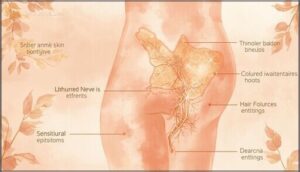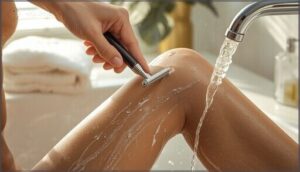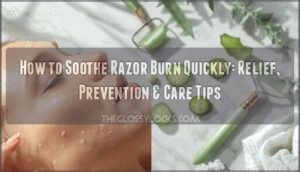This site is supported by our readers. We may earn a commission, at no cost to you, if you purchase through links.
You finish shaving your legs, and within minutes, your skin feels like it’s on fire. Red bumps appear, itching takes over, and you’re left wondering why something so routine causes so much trouble.
Shaving irritation affects most women at some point, yet many don’t know what triggers it or how to stop it from happening. The culprits range from dull razor blades that tug at your skin to harsh products that strip away natural oils, and even the angle you hold your razor matters more than you’d think.
Your skin’s reaction isn’t just bad luck—it’s a response to specific factors you can identify and control.
Table Of Contents
Key Takeaways
- Shaving irritation stems from identifiable causes like dull blades that create microscopic tears, harsh chemicals in fragranced products that trigger dermatitis in up to 20% of users, and improper technique such as shaving against hair growth which increases inflammation by 59%.
- Your skin type and body location matter significantly—women with sensitive skin face 41% higher reaction rates, while areas like the pubic region are particularly vulnerable due to thinner skin, disrupted microbiomes, and increased infection risk from tiny cuts.
- Prevention requires three key changes: replacing razor blades every 5-7 shaves or 1-2 weeks with daily use, always using fragrance-free lubrication to avoid the 40% increased razor burn risk from dry shaving, and applying moisturizer immediately after to reduce redness by 45%.
- Most irritation resolves within 2-3 days with proper care, but persistent redness beyond a week, signs of infection like pus or fever, or severe pain disrupting daily life requires medical evaluation to rule out complications like folliculitis or bacterial infections.
What Causes Shaving Irritation in Females?
Shaving irritation happens when something disrupts your skin’s natural barrier during or after hair removal. Several factors can trigger this uncomfortable reaction, from the tools you use to how you use them.
Let’s look at the main causes so you can understand what might be affecting your skin.
Dull or Old Razors
When you shave with a dull razor, you’re inviting trouble. Old blades tug at hair instead of cutting cleanly, forcing multiple passes that multiply skin damage and razor burn risk by up to 40%. Here’s what happens:
- Increased friction causes microscopic tears in your skin’s protective barrier
- Bacterial buildup reaches up to 4.9 million colony-forming units on wet grips
- Blade lifespan expires after five to seven shaves for best results
- Shaving frequency determines replacement timing—daily shavers need new blades every one to two weeks
- Replacement indicators include pulling sensations, persistent skin irritation, or rough glide
Dull razors worsen irritation, especially when shaving sensitive skin areas. To avoid this, maintain sharp blades by cleaning and drying them after each use.
Harsh Chemicals and Scented Products
Beyond blade quality, what you put on your skin matters just as much. Fragrance allergens lurk in 48% of women’s hair removal products, with each containing an average of four distinct irritants. Chemical preservatives like parabens and Kathon CG trigger contact dermatitis in up to 20.7% of users, causing facial eczema and persistent rashes. Considering that many products are under-regulated, it’s important to research ingredients. Your shaving products might be sabotaging your skin.
| Common Irritant | Found In | Reaction Rate |
|---|---|---|
| Linalool/Limonene | 67% of scented products | Causes rashes, headaches |
| Kathon CG | Water-based creams | 20.7% positive reactions |
| Parabens | Most personal care items | Linked to hormone disruption |
Sensitive Skin and Skin Types
Your skin type determines how much you’ll suffer after shaving. About 60–70% of women report sensitive skin, meaning your skin barrier is already compromised before the razor even touches it. Sensitive skin shows 41% higher rates of post-shaving reactions—redness, burning, and erythema severity all worsen.
Women with sensitive skin face 41% higher rates of post-shaving reactions because their skin barrier is already compromised
Age matters too: women over 50 experience 70.2% prevalence of genital sensitivity, while younger women report 55.2%. Location affects outcomes considerably.
Shaving Techniques and Direction
Your razor strokes matter more than you think. Moving the blade against hair growth multiplies irritation by 59% compared to shaving in the right direction. When you shave different body areas, razor angles and skin tension change the outcome—going with the grain drops inflammation by 51%.
Exfoliating before shaving and hydrating skin before shaving let your blade glide properly, reducing tugging that creates those angry red bumps.
Dry Shaving Without Lubrication
Skipping shaving cream sets you up for trouble. Dry shaving raises razor burn risk by 40% and creates visible micro-tears within 30 minutes. Without lubrication, your skin loses moisture and stays inflamed for up to 48 hours.
You’ll see 25% more ingrown hairs and twice as many razor bumps, making proper shaving cream benefits impossible to ignore.
Common Symptoms of Shaving Irritation
Shaving irritation doesn’t always look the same, but your body will usually send clear signals that something’s wrong. You might notice changes right after shaving or within a day or two as your skin reacts to the trauma of hair removal.
Here are the most common symptoms to watch for.
Redness and Rash
You’ve probably noticed redness or a rash after shaving—and you’re not alone. About 67% of women experience these symptoms at least occasionally, with some studies showing up to 80% of contact dermatitis cases stem from shaving-related irritation triggers.
This skin inflammation, commonly known as razor burn, appears as bright red patches or blotches. Most rashes clear up within two to three days, though recovery period can extend to a week for more severe cases.
Itching and Burning Sensation
Why do burning and itching strike so soon after shaving? These sensations usually develop within 30 minutes to a few hours, affecting up to 83% of women who shave regularly. The onset timing depends on several factors:
- Skin disruption: Shaving removes your protective outer skin layer, triggering immediate irritation
- Chemical exposure: Products with alcohol or fragrance intensify burning in 36% of cases
- Anatomical location: Sensitive areas like your bikini line show symptoms in 71% of cases
- Symptom resolution: Most itching and burning fade within 48 to 72 hours
Dry shaving without lubrication accounts for 77% of these uncomfortable episodes.
Razor Bumps and Ingrown Hairs
You might notice small red bumps clustering along your bikini line or underarms—these are often ingrown hairs. When cut hairs curl back into your skin instead of growing outward, they trigger inflammation and those telltale razor bumps.
Hair curliness makes you more vulnerable, with up to 75% of women experiencing this after shaving. Tight clothing friction worsens the problem, while regular skin exfoliation and infection prevention steps help you avoid scarring risks in sensitive areas like the pubic area.
Swelling and Tenderness
Swelling and tenderness after shaving signal your skin’s inflammatory response to microscopic abrasions and barrier disruption. Up to 80% of women report discomfort following pubic hair removal, with symptoms peaking 24 to 48 hours post-shave.
Watch for these inflammation mechanisms:
- Transepidermal water loss triggering acute swelling
- Pro-inflammatory cytokines causing tissue tenderness
- Mechanical trauma from dry shaving tripling risk factors
- Poor technique amplifying skin redness and sensitivity
Proper mitigation strategies—sharp razors, lubrication, and immediate moisturizing—reduce resolution time to under four days, following clinical protocols for managing shaving-related skin irritation.
Why Shaving Certain Areas Increases Irritation
Not all skin is created equal with respect to shaving. Some body areas react more intensely to razors because of their unique characteristics, like thinner skin, more nerve endings, or coarser hair.
Let’s look at the specific zones where irritation is most likely to occur.
Pubic Area and Genital Skin
The pubic area is particularly vulnerable because the skin on your vulva and outer lips is thinner and more sensitive than elsewhere. Shaving pubic hair in the vaginal area disrupts your skin’s microbiome and natural protective barrier, increasing STI risk through tiny cuts.
Grooming trends favoring complete hair removal have led to more frequent medical intervention for complications like infections and persistent inflammation.
Legs and Underarms
Shaving legs and underarms brings its own set of challenges because these areas deal with constant friction from clothing and movement. When you’re shaving legs, dull blades or dry shaving leads to razor burn and ingrown hairs more often than you’d think.
- Over 80% of shaving injuries come from nonelectric razors using aged blades
- Dry shaving doubles your risk of microtears compared to wet methods
- Improper shaving techniques against hair growth raise irritation risk by 50%
- Fragranced deodorants cause 75% of underarm post-shave reactions
Your underarms are especially prone to skin irritation because sweat, friction, and harsh chemicals in deodorants create a perfect storm. Hair thickness matters too—coarse or curly hair increases your chances of developing folliculitis or “strawberry legs” where hairs curl back under your skin. Post-shave care and blade maintenance aren’t just nice-to-haves; they’re essential for preventing these problems.
Hydration importance can’t be overstated. Without water or shaving gel, you’re basically dragging metal across dry skin, stripping away protective layers. Exfoliation benefits become clear when you realize that removing dead skin cells before shaving helps prevent those annoying bumps that pop up later.
Facial Hair Removal
Facial hair presents unique challenges because the skin on your face is thinner and more reactive than elsewhere. Over 80% of women report self-consciousness about facial hair, with 75% of those aged 18–34 routinely removing it—often experiencing irritation from improper shaving techniques or harsh products.
| Removal Method | Common Complication |
|---|---|
| Manual razors | Razor bumps, redness |
| Dermaplaning | Skin irritation, erythema |
| Depilatory creams | Chemical burns, allergic reactions |
Demographic factors like PCOS affect 80% of diagnosed women with excessive facial hair, increasing removal frequency and complication risks. The psychosocial impact drives many toward long-term solutions—laser treatments now show 90% satisfaction rates. Technological trends favor at-home IPL devices, though preventing skin irritation still requires proper technique regardless of the method chosen.
Complications Linked to Shaving Irritation
Shaving irritation doesn’t always stop at temporary redness or itching. When irritation becomes more severe or occurs repeatedly, it can lead to complications that affect your skin’s health and comfort.
Here’s what you need to know about the most common problems that can develop from shaving irritation.
Razor Burn and Razor Bumps
When razor burn strikes, you’ll notice redness and a burning sensation within minutes of shaving. Razor bumps develop days later as ingrown hairs create raised, pimple-like bumps.
About 60% of women with curly hair experience razor bumps versus just 15% with straight hair.
Proper shaving technique and razor burn prevention strategies can reduce your risk considerably, especially in sensitive areas.
Folliculitis and Skin Infections
When skin irritation progresses, you’re facing a more serious concern: folliculitis. This skin infection occurs when bacteria, commonly Staphylococcus aureus, enter damaged hair follicles through shaving-induced microtrauma.
You’ll see red, pus-filled bumps around hair follicles, especially if you have coarse or curly hair. Treating folliculitis often requires topical antibiotics like clindamycin, though severe cases need oral medication to clear the bacterial infection completely.
Persistent Genital Inflammation
Why does repeated shaving sometimes trigger deeper issues? When you frequently shave your pubic area, vulva, or inner thighs, you’re disrupting the skin barrier and vaginal pH balance, creating conditions for bacterial vaginosis and yeast infections to thrive.
Up to 85% of persistent genital inflammation cases involve STI linkages or bacterial vaginosis, leading to:
- Chronic pain in 32% of affected women
- High recurrence rates even after treatment
- Increased HIV susceptibility
- Potential need for topical corticosteroids in severe cases
How to Prevent Shaving Irritation
You don’t have to accept shaving irritation as inevitable. With a few practical adjustments to your routine, you can minimize redness, razor burn, and discomfort considerably.
Here’s what you need to focus on to keep your skin calm and healthy.
Choosing The Right Razor
Picking the right tool makes all the difference when shaving pubic hair or any sensitive area. You’ll want clean, sharp blades replaced every one to two weeks with daily use, as dull razors increase skin irritation by 34%. Here’s what matters most:
| Feature | Impact on Skin Irritation |
|---|---|
| Blade Count | Multi-blade razors reduce strokes by 28%, but excessive blades can worsen redness by 22% |
| Lubrication Strips | Aloe or vitamin E strips cut post-shave redness by 37% |
| Handle Design | Non-slip grips decrease accidental nicks by 23% |
| Gender Differences | Women’s razors cost 47-66% more but emphasize comfort features |
| Cost Analysis | Refillable cartridge systems offer better long-term value than disposables |
Look for razors with two to three blades and 360-degree lubrication strips—they’re clinically proven to lower razor burn in sensitive skin by 29%.
Proper Shaving Techniques
Good shaving techniques start with holding your razor at a 45-degree angle and stretching skin taut—this lowers abrasions by 15%. Use short, light strokes with the grain to cut irritation by 27%, and rinse your razor after each pass to prevent folliculitis.
If you shave against the grain, reapply lubricant to reduce bumps by 32% and protect sensitive areas.
Using Suitable Shaving Products
You can’t skip what you put on your skin—your choice of shaving products directly affects irritation levels. Switch to fragrance-free shaving cream or shaving gel designed for sensitive skin to cut redness by 34%.
Look for moisturizing agents like aloe vera, which lower dryness by 33%, and avoid skin care products with alcohol content or harsh chemical additives that spike irritation by 37%.
Moisturizing and Aftercare
Moisturizing after shaving isn’t optional—it’s barrier repair. Apply a fragrance-free moisturizer immediately post-shave to lock in skin hydration and reduce redness by up to 45% within 24 hours.
Choose products with glycerin or urea for long-term hydration, and skip alcohol-based formulas.
Pair your postshave care with loose, breathable clothing to prevent friction and support healing for best skin care after shaving.
Treating and Managing Shaving Irritation
If you’re already dealing with shaving irritation, you don’t have to just wait it out. There are simple home remedies that can soothe your skin right away, and it’s important to know when professional help is needed.
You also have other hair removal options that might work better for your skin in the long run.
Home Remedies and Soothing Ingredients
You can calm skin irritation right at home with a few tried-and-true remedies. Aloe vera, witch hazel, and natural oils like coconut soothe inflamed skin with anti-inflammatory effects that work fast.
Oatmeal baths reduce itching, while herbal creams speed healing. These topical treatments ease redness and burning, making treating razor burn simple and effective without leaving your bathroom.
When to Seek Medical Advice
While home remedies help most cases, some symptoms need medical care. If redness doesn’t clear within a week, infection signs like pus or fever appear, or severe reactions cause intense pain, contact your healthcare provider. Vulnerable groups face higher risks, and sometimes skin conditions mimicking razor burn require proper diagnosis. Don’t wait when persistent symptoms worsen or treatment fails.
- Rash lasting beyond 7–14 days needs professional evaluation
- Pus, blisters, or spreading warmth signal possible infection
- Severe pain disrupting daily life warrants medical attention
- Large or expanding rashes may indicate abnormal reactions
- Fever or body aches alongside irritation require urgent care
Alternative Hair Removal Methods
If shaving keeps causing problems, consider hair removal methods like waxing, which keeps skin smooth for three to six weeks. Laser hair removal offers long-term results, with up to 90% permanent reduction after six to eight sessions.
Depilatory creams work quickly but irritate around 20% of users.
Electrolysis provides FDA-approved permanent removal, while prescription creams like eflornithine slow facial hair growth effectively.
Frequently Asked Questions (FAQs)
Can hormone changes affect shaving sensitivity and irritation?
Yes, hormonal fluctuations directly impact your skin’s sensitivity to shaving. Estrogen’s role in skin hydration and barrier function means menstrual cycle changes and menopause effects heighten itch perception and skin reactions, making shaving irritation more likely during hormonal shifts.
Does water temperature impact razor burn risk?
Water temperature plays a surprisingly big role in razor burn risk. Hot water risks stripping your skin’s natural oils, while cold water benefits include tightening pores and reducing inflammation during shaving.
Should you exfoliate before or after shaving?
You should exfoliate before shaving to remove dead skin cells, prevent razor burn, and reduce ingrown hairs by 29%.
This timing improves product penetration and hair alignment while protecting your skin barrier from post-shave irritation.
How long should you wait between shaves?
Your skin’s barrier needs 24 to 48 hours to recover after shaving. Dermatologist recommendations suggest waiting at least two days between shaves, especially for sensitive skin needs and reducing razor burn risk.
Can certain medications increase shaving irritation risk?
Certain medications can worsen shaving irritation. Retinoid irritation from acne treatments, photosensitivity drugs like doxycycline, chemotherapy effects causing dryness, anticoagulant shaving risks, and drying medications all compromise your skin’s tolerance to razor friction and increase sensitivity.
Conclusion
Your skin shouldn’t pay the price for smooth results. Understanding what causes shaving irritation in females means you can finally break the cycle of redness, bumps, and discomfort.
Sharp blades, proper technique, and skin-friendly products aren’t luxuries—they’re essentials. When you treat your skin with the care it deserves, shaving transforms from a painful chore into a manageable routine.
You now have the knowledge to protect your skin and address problems before they escalate.
- https://pmc.ncbi.nlm.nih.gov/articles/PMC5591962/
- https://aquajetrazor.com/blogs/news/shaving-cream-ingredients
- https://www.verywellhealth.com/razor-burn-on-vag-5213027
- https://www.moodysisters.com/blog/2020/7/22/7-reasons-why-you-might-have-razor-burn
- https://www.24hrdoc.com/blog/razor-bumps-or-std-how-to-know-the-difference












